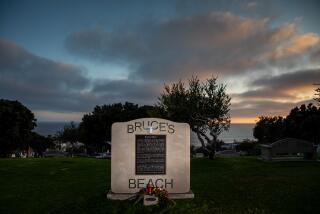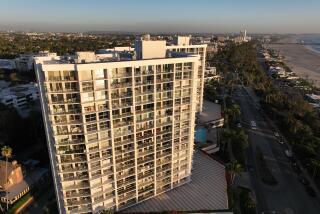Condo Suit to Be Subject of Mediation : Thousand Oaks: Homeowners will discuss allegations of shoddy workmanship with the developer at a hearing.
A 3-year-old lawsuit over allegations of shoddy construction at a 648-unit condominium complex in the Hidden Canyon area of Thousand Oaks will be the subject of an unusual weeklong mediation hearing next week involving up to 200 people.
Representatives of the Hidden Canyon Homeowners Assn., defendant Griffin Homes and more than 50 subcontractors will gather for a five-day hearing to be held in Universal City beginning July 19.
“The homeowners association is anxious to have this entire case resolved,” said Alexander Robertson, the attorney representing the association. “The lawsuit has already dragged on too long. If Griffin tries to stonewall, the damages are just going to triple.”
About 200 people are expected to attend the mediation hearing, including homeowners, insurance adjusters, attorneys and building experts.
Because it is such a large and complex case, Robertson said a second weeklong mediation session will be held beginning Aug. 12. A state-appointed mediator--retired Los Angeles Superior Court Judge Robert Weil--will preside over both meetings.
Attorney Bob Cohen of the law firm Zimmerman & Kahanowitch, which is representing Griffin Homes, said the developer has admitted no wrongdoing and is also hopeful that the matter can be resolved without going to trial.
The Hidden Canyon Homeowners Assn. filed its lawsuit against the Calabasas-based builder in 1991 to try to force the developer to pay for extensive repairs made at the condominium complex.
Homes originally sold for $80,000 to $140,000 in 1984 when the first units were built, but some have sold for as much as $160,000 since then, according to area realtors.
In the lawsuit, residents contended that the complex was built defectively and deteriorated over a short period of time. They complained about leaky roofs, cracked walls and uneven floors.
But the case was stalled after Griffin changed attorneys, then was further delayed when the developer filed for Chapter 11 bankruptcy protection in March, 1992.
Since the homeowners’ association filed its lawsuit, the organization has spent about $1.2 million on repairs, Robertson said.
“But these are just temporary repairs,” he said, noting that heavy rains during the past three years have caused extensive and repeated damage to some homes. “Every time it rains it gets flooded out. The homeowners can’t stand to go through another rainy season.”
The association’s original lawsuit asked for about $10 million in damages. But the group recently hired private consultants to determine the exact cost of structural damages and repeated repairs that have been made by homeowners.
As a result, the association is now asking for $56 million, Robertson said.
Cohen said that the developer’s insurers have hired their own building consultants to help present Griffin’s case at the mediation session, but declined to discuss their findings.
Cohen noted, however, that dozens of subcontractors were involved in the building of the condominium complex and that they, and not Griffin, may be liable for damages.
Robertson said while Griffin is pointing the finger at some of its subcontractors, there is evidence that Griffin may hold the greatest responsibility.
Robertson said he and his staff have uncovered several “smoking gun memos” while sifting through Griffin’s company records, which the court had ordered be put into a repository so that homeowners would be able to examine them.
Robertson said he has found letters written by subcontractors to Griffin pointing out defects they had discovered during construction of the complex.
For example, Robertson said, one subcontractor notified Griffin that the builder had failed to reinforce Sheetrock with waterproofing materials and that the walls would eventually leak if simply covered with stucco.
Robertson said the subcontractor was directed to do the work regardless.
“This points out that Griffin had knowledge of the problem, but said go ahead and do it anyway,” Robertson said. “Griffin was forcing them to do shoddy work and finish the buildings.”
In another instance, according to Robertson, Griffin hired a roofing expert from Texas in 1988 to examine the roof at the condominium complex after the developer was forced to make several repairs.
The consultant wrote in a report to the developer that the building had serious roofing defects and that problems would probably persist over the life of the structure, Robertson said.
“But this was never disclosed to homeowners,” Robertson said.
Cohen declined to comment on Robertson’s allegations.
“I don’t know where he’s getting this information,” Cohen said. “I don’t know if it’s accurate.”
Robertson said Griffin did pay for some, but not all, repairs needed prior to the filing of the lawsuit. The developer has not paid for any repairs since.
More to Read
Sign up for Essential California
The most important California stories and recommendations in your inbox every morning.
You may occasionally receive promotional content from the Los Angeles Times.






